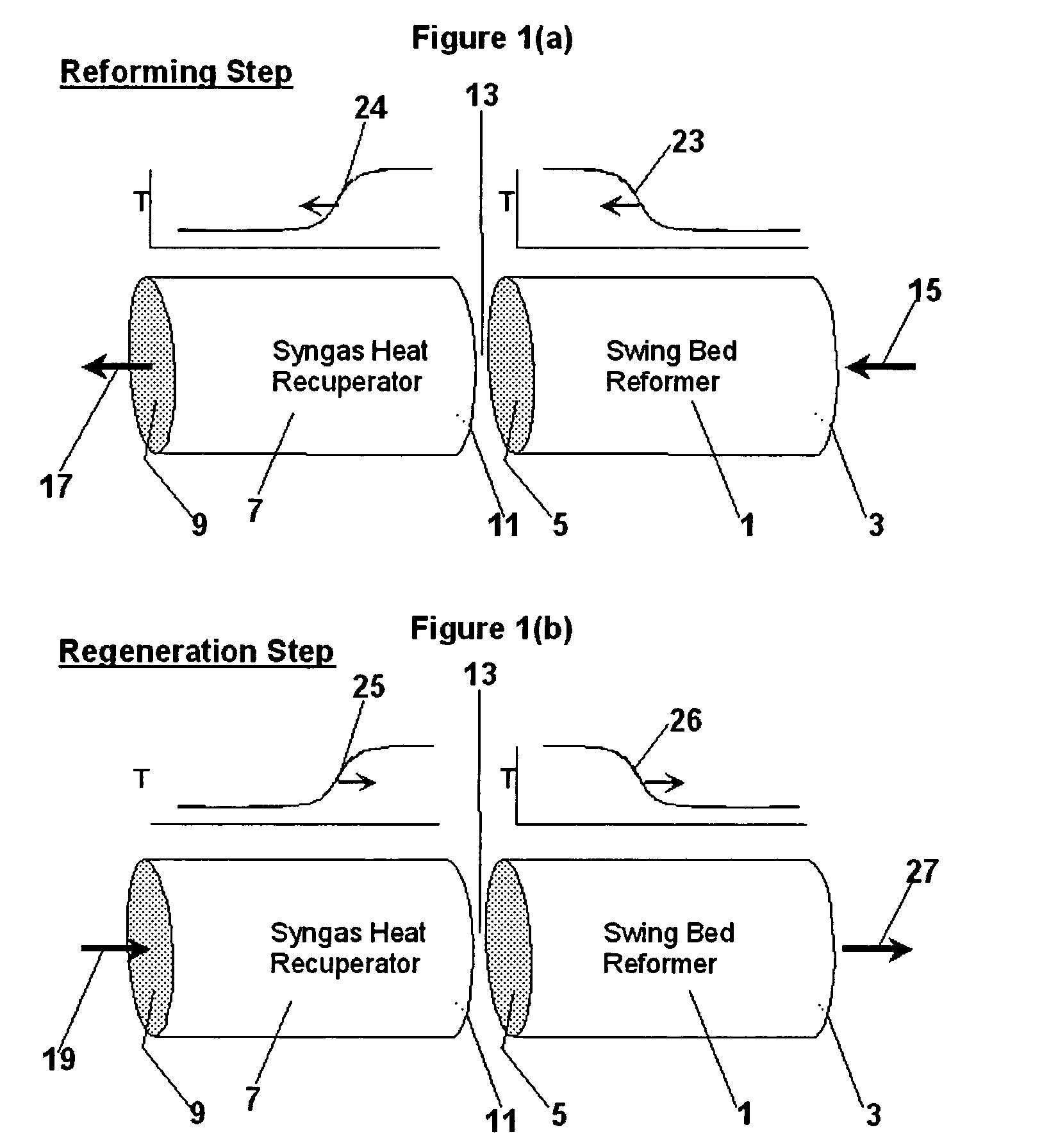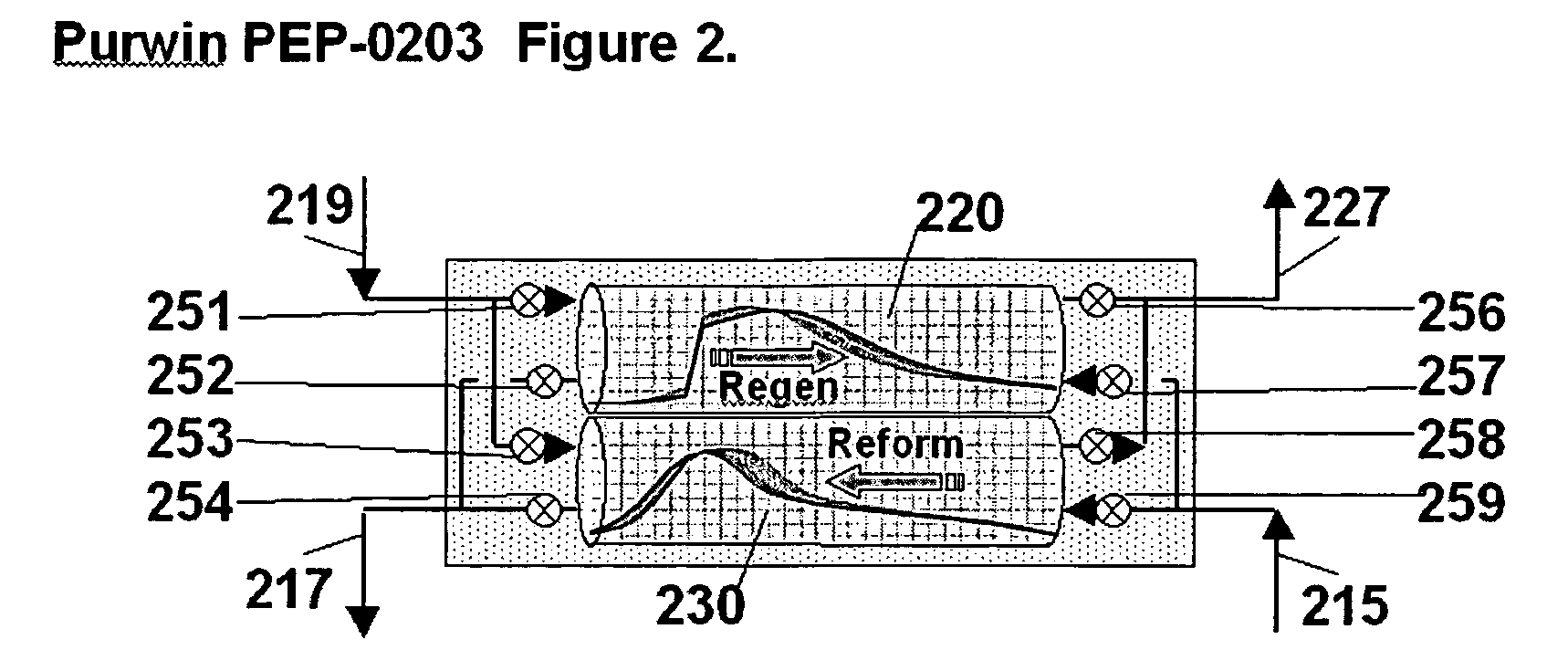Pressure swing reforming for fuel cell systems
a fuel cell and pressure swing technology, applied in the direction of combustible gas production, sustainable manufacturing/processing, separation processes, etc., can solve the problems of limiting the utility of steam reform furnaces in point-of-use fuel applications, occupying a large space, and substantially greater than the volume of tubes
- Summary
- Abstract
- Description
- Claims
- Application Information
AI Technical Summary
Benefits of technology
Problems solved by technology
Method used
Image
Examples
example 1
[0081]To illustrate one embodiment of the present invention, an amount of iso-octane was processed using the pressure swing reforming process illustrated in FIG. 4. The hydrogen separation means in this example is a supported palladium membrane, operating at a temperature of about 350° C. Key system parameters are identified in Table 1 below:
[0082]
TABLE 1Stream Identity411,401 + 403407409429430427ReformShiftH2RecycleDepletedFlueFeedOutletProductPurgeAirGasT, ° C.200360350350200420P, Atm ga9909 to 0.50.50gmol. / minIC81.70CH40.408.408H2O20.4063.010.001.3312.1520.04H20.0033.5932.2282.330.000.00CO0.007.320.007.320.000.00CO20.005.8750.005.870.0010.30N20.000.070.000.0079.9679.96O20.000.000.000.005.65ΔHc, kW14317812649
[0083]This example utilizes two PSR reactors, operated as described with respect to FIG. 2 to provide a substantially continuous stream of product. The cycle time is about 15 seconds, with regeneration and reforming each operating about half the cycle. During the reforming ste...
example 2
[0084]To illustrate another embodiment of the present invention, an amount of methane was processed using the pressure swing reforming process illustrated in FIG. 5, but without the steam boiler (502). The hydrogen separation means in this example is a polymer membrane, operating at a temperature of about 100° C. Key system parameters are identified in Table 2 below:
[0085]
TABLE 2Stream Identity501 + 503507509511530527ReformShiftH2RecycleDepletedFlueFeedOutletProductPurgeAirGasT, ° C.400500100100400530P, Atm ga.9919 to 0.50.50gmols / minCH412.370.3700.37H2O20.253.3903.3918.321.89H2039.9237.072.85CO08.2108.21CO203.7703.7712.35N200.0700.0793.493.4O200006.26ΔHc, kW16019914554
[0086]This example makes use of two PSR reactors, operated as described with respect to FIG. 2 to provide a substantially continuous stream of product. The cycle time is 6 seconds, with regeneration and reforming each operating half the cycle. During the reforming step, the fuel flow is terminated about 0.1 sec before...
example 3
[0087]To illustrate another embodiment of the present invention, an amount of methane was processed using the pressure swing reforming process illustrated in FIG. 3. In this example, the fuel cell is a proton conducting solid oxide fuel cell (“SOFC”) operating at about 500° C. SOFC anode and cathode effluents (streams 318&312) are used as PSR regeneration feed (streams 329&330). Waste heat from the SOFC and the regeneration effluent (327) are used to make steam and provide preheat (not shown) of PSR and SOFC feeds, as needed. Water for steam is condensed from a cooled regeneration effluent (stream 327; cooling and condensation not shown). Key system parameters are identified in Table 3 below:
[0088]
TABLE 3Stream Identity301 +303305H2318 / 329312 / 330327ReformReformConsumedAnodeCathodeRegeninoutIn SOFCEffluentEffluentEffluentTemp, C500511500500459Pres. Atm*0.20.20.10.10Gmols / minCH44.120.120.12H2O6.331.750.7413.5714.55H212.5613.57CO3.502.48CO20.501.524.12N20.070.0731.2131.21O21.49ΔHc, kW5...
PUM
| Property | Measurement | Unit |
|---|---|---|
| inlet temperature | aaaaa | aaaaa |
| temperature | aaaaa | aaaaa |
| temperatures | aaaaa | aaaaa |
Abstract
Description
Claims
Application Information
 Login to View More
Login to View More - R&D
- Intellectual Property
- Life Sciences
- Materials
- Tech Scout
- Unparalleled Data Quality
- Higher Quality Content
- 60% Fewer Hallucinations
Browse by: Latest US Patents, China's latest patents, Technical Efficacy Thesaurus, Application Domain, Technology Topic, Popular Technical Reports.
© 2025 PatSnap. All rights reserved.Legal|Privacy policy|Modern Slavery Act Transparency Statement|Sitemap|About US| Contact US: help@patsnap.com



